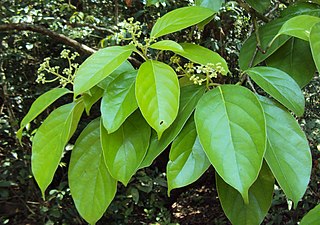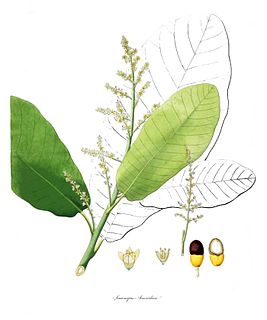
Plumeria, known as frangipani, is a genus of flowering plants in the subfamily Rauvolfioideae, of the family Apocynaceae. Most species are deciduous shrubs or small trees. The species variously are endemic to Mexico, Central America, and the Caribbean, and as far south as Brazil and north as Florida, but are sometimes grown as cosmopolitan ornamentals in warm regions. Common names for plants in the genus vary widely according to region, variety, and whim, but frangipani or variations on that theme are the most common. Plumeria is also used as a common name, especially in horticultural circles.

Mastixia is a genus of about 19 species of resinous evergreen trees, usually placed in the family Cornaceae. Its range extends from India through Southeast Asia and New Guinea to the Solomon Islands. Mastixia species have alternate or opposite simple broad leaves, many-flowered inflorescences, and blue to purple drupaceous fruits.
Semecarpus acuminatus is a species of plant in the family Anacardiaceae. It is native to Sri Lanka, Sri Lanka, Bangladesh and Myanmar. The specific epithet was originally spelt acuminata.

Semecarpus is a genus of plants in the family Anacardiaceae.

Semecarpus auriculatus is a species of plant in the family Anacardiaceae. It is endemic to India. The specific epithet was originally spelt auriculata.
Semecarpus coriaceus is a species of plant in the family Anacardiaceae. It is endemic to Sri Lanka. The specific epithet was originally spelt coriacea.
Semecarpus nigroviridis is a species of plant in the family Anacardiaceae. Its native range includes Bangladesh, Sri Lanka and Borneo.
Semecarpus ochraceus is a species of plant in the family Anacardiaceae. It is endemic to Sri Lanka. The specific epithet has also been spelt ochracea.
Semecarpus parvifolius is a species of plant in the family Anacardiaceae. It is endemic to Sri Lanka. The specific epithet was originally spelt parvifolia.
Semecarpus pseudoemarginatus is a species of plant in the family Anacardiaceae. It is endemic to Sri Lanka. The specific epithet is also spelt pseudo-emarginata.
Semecarpus pubescens, the velvet badulla, is a species of plant in the family Anacardiaceae. It is endemic to Sri Lanka.
Semecarpus riparius is a species of plant in the family Anacardiaceae. It is endemic to New Caledonia. The specific epithet is also spelt riparia.
Semecarpus subpeltatus is a species of plant in the family Anacardiaceae. It is endemic to Sri Lanka. The specific epithet was originally spelt subpeltata.
Semecarpus walkeri is a species of plant in the family Anacardiaceae. It is endemic to Sri Lanka.

Semecarpus australiensis, commonly known as the tar tree, native cashew, marking nut, or cedar plum, is a species of tree in the cashew, sumac and mango family Anacardiaceae, native to parts of Melanesia and northern Australia. Contact with the plant can cause serious allergic reactions, a common characteristic of this family.

Adenanthos obovatus, commonly known as basket flower, or, jugflower, is a shrub of the plant family Proteaceae endemic to Southwest Australia. Described by French naturalist Jacques Labillardière in 1805, it had first been collected by Archibald Menzies in 1791. Within the genus Adenanthos, it lies in the section Eurylaema and is most closely related to A. barbiger. A. obovatus has hybridized with A. detmoldii to produce the hybrid A. × pamela. Several common names allude to the prominent red flowers of the species. It grows as a many-stemmed spreading bush up to 1 m (3.3 ft) high, and about 1.5 m (4.9 ft) across, with fine bright green foliage. Made up of single red flowers, the inflorescences appear from April to December, and peak in spring.

Semecarpus travancoricus is a species of plant in the family Anacardiaceae native to India and Bangladesh. The specific epithet was originally spelt travancorica. In India, it is found in the southern Western Ghats in South India. It is a tree of evergreen forests and is found only south of the Anamalais at an elevation around 1300 MSL.
Adenanthos × pamela is a naturally occurring hybrid of A. detmoldii and A. obovatus in Western Australia.

Adenanthos sect. Eurylaema is a taxonomic section of the flowering plant genus Adenanthos (Proteaceae). It comprises four species, all of which are endemic to southwest Western Australia.

Sonerila is a genus of plants in the family Melastomataceae. This genus is characterized the by presence of three petals as opposed to five in the other members of the family. Most members of the genus prefer growing in shady habitats. It is a large genus including about 175 species.









